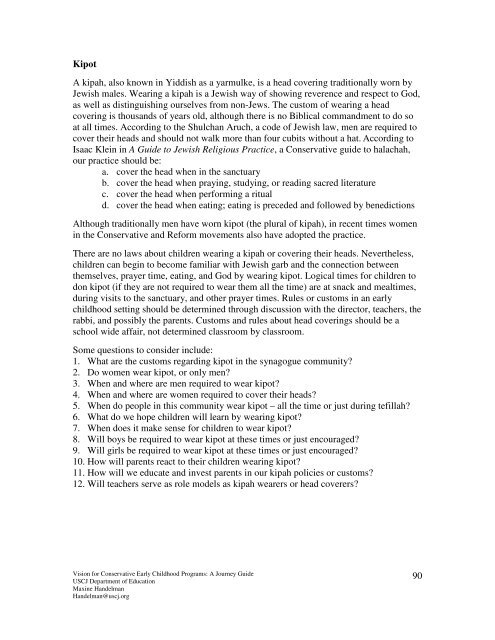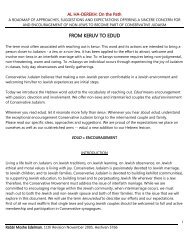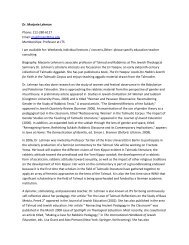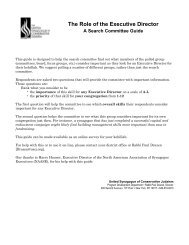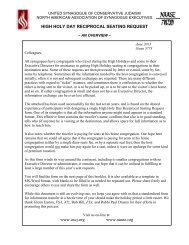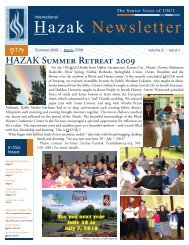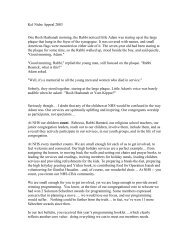Vision for Conservative Early Childhood Programs: A Journey Guide
Vision for Conservative Early Childhood Programs: A Journey Guide
Vision for Conservative Early Childhood Programs: A Journey Guide
You also want an ePaper? Increase the reach of your titles
YUMPU automatically turns print PDFs into web optimized ePapers that Google loves.
Kipot<br />
A kipah, also known in Yiddish as a yarmulke, is a head covering traditionally worn by<br />
Jewish males. Wearing a kipah is a Jewish way of showing reverence and respect to God,<br />
as well as distinguishing ourselves from non-Jews. The custom of wearing a head<br />
covering is thousands of years old, although there is no Biblical commandment to do so<br />
at all times. According to the Shulchan Aruch, a code of Jewish law, men are required to<br />
cover their heads and should not walk more than four cubits without a hat. According to<br />
Isaac Klein in A <strong>Guide</strong> to Jewish Religious Practice, a <strong>Conservative</strong> guide to halachah,<br />
our practice should be:<br />
a. cover the head when in the sanctuary<br />
b. cover the head when praying, studying, or reading sacred literature<br />
c. cover the head when per<strong>for</strong>ming a ritual<br />
d. cover the head when eating; eating is preceded and followed by benedictions<br />
Although traditionally men have worn kipot (the plural of kipah), in recent times women<br />
in the <strong>Conservative</strong> and Re<strong>for</strong>m movements also have adopted the practice.<br />
There are no laws about children wearing a kipah or covering their heads. Nevertheless,<br />
children can begin to become familiar with Jewish garb and the connection between<br />
themselves, prayer time, eating, and God by wearing kipot. Logical times <strong>for</strong> children to<br />
don kipot (if they are not required to wear them all the time) are at snack and mealtimes,<br />
during visits to the sanctuary, and other prayer times. Rules or customs in an early<br />
childhood setting should be determined through discussion with the director, teachers, the<br />
rabbi, and possibly the parents. Customs and rules about head coverings should be a<br />
school wide affair, not determined classroom by classroom.<br />
Some questions to consider include:<br />
1. What are the customs regarding kipot in the synagogue community?<br />
2. Do women wear kipot, or only men?<br />
3. When and where are men required to wear kipot?<br />
4. When and where are women required to cover their heads?<br />
5. When do people in this community wear kipot – all the time or just during tefillah?<br />
6. What do we hope children will learn by wearing kipot?<br />
7. When does it make sense <strong>for</strong> children to wear kipot?<br />
8. Will boys be required to wear kipot at these times or just encouraged?<br />
9. Will girls be required to wear kipot at these times or just encouraged?<br />
10. How will parents react to their children wearing kipot?<br />
11. How will we educate and invest parents in our kipah policies or customs?<br />
12. Will teachers serve as role models as kipah wearers or head coverers?<br />
<strong>Vision</strong> <strong>for</strong> <strong>Conservative</strong> <strong>Early</strong> <strong>Childhood</strong> <strong>Programs</strong>: A <strong>Journey</strong> <strong>Guide</strong><br />
USCJ Department of Education<br />
Maxine Handelman<br />
Handelman@uscj.org<br />
90


